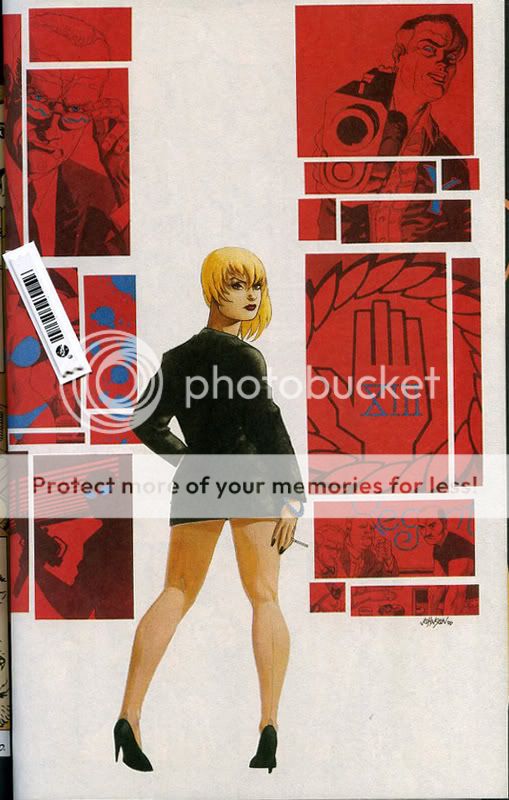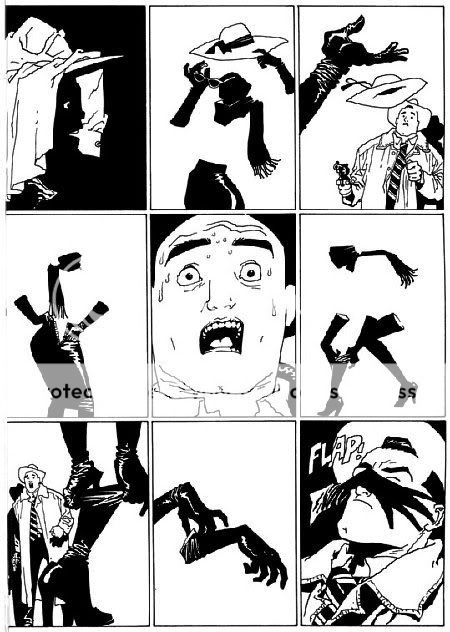So probably my favorite part of the brouhaha over my dislike of 100 Bullets was that I got in a flamewar with mediocre mainstream scripter Mark Waid. Here’s our back and forth:
Mark:
I, on the other hand, unlike Ross, am happy to just flat-out insult, because this kind of nonsense blogpost, shat out by a self-styled guardian of culture who thinks “mediums” is the plural of “medium,” is largely a waste of electrons and does nothing to elevate any sort of discourse. If there were a FailBlog.org site for reviews, this would lead the list.
The only fair yardstick against which any work of art can be measured is how well it accomplished whatever the hell it set out to accomplish. Every critic’s mileage will vary, but the critics who tend to be worth listening to are the ones who demonstrate, at the very least, enough critical acumen to be able to tell the difference between Ed Risso and Dave Johnson. Particularly when Dave Johnson’s signature is about the size of a matchbook.
Me:
Holy crap. Mark Waid cares enough to post. Hey Mark! I was just reading some of your amazingly mediocre efforts on Justice League. You are the last person whose opinion about writing I would take…I may even keep using “mediums” as the plural just to distance myself from your lameness. Cheers!
Mark then went over to Heidi’s comments to say:
Wow. Just left a reply on the guy’s blog because, as a friend of Dave’s, I was pissed–but I realize now that was a waste of time. He’s just another yutz with a keyboard. But I hope he enjoys the little moment in the sun we’ve given him!
I posted a link to my follow-up post on Heidi’s comments, prompting the following exchange
:
Mark:
“Hey all. I’ve got a follow up post here:”
Or, to put it another way, “HEY!!!! LOOK AT ME, EVERYBODY!!!!!!”
I repeat: I hope this halfwit is enjoying his moment in the sun, since it’s probably the only one he’ll ever get. C’mon, everybody…let the baby have his bottle. Move along. Nothin’ to see here.
Me:
Hey Mark! I’m on my tenth or eleventh Internet brouhaha at this point, actually. But, yes, I’m enjoying the moment, as I hope you’ve enjoyed your run of sub-Claremont hackery. Really, seeing you pop up and offer aesthetic opinions is like that old Dr. Johnson joke about the dog walking on hind legs…you don’t do it especially well, but it’s surprising to see you do it at all.
It’s probably wrong to have enjoyed that quite so much…but so it goes.
Anyway, I thought that as long as I’d raised the issue, I should maybe go back and reread something of Waid’s and see if it was as tedious as I (vaguely) remembered. The one entire book of his I”ve got lying around is “Justice League: Midsummer Nightmare”, written with Fabian Nicieza. I bought it because it’s a prequel of sorts to the Grant Morrison run on JLA. I didn’t remember it as being especially good, but I thought I’d give it another whirl.
Or try to. I had to give up; it’s largely unreadable. The initial idea (everybody on earth is getting super-powers) is okay, but the execution is phenomenally dreary. In an intro, Grant Morrison praises this book for turning its back on the bad-old-nastiness of dark gritty comics from the 80s and 90s, and ushering a new silver age full of fun! and excitement! In fact, though, this isn’t Dark Age, or Silver Age, but a Color-of-Lukewarm-Porridge Age. This is where bits and pieces of comic stories past come to die; zombified tropes wander about, robbed of all meaning and purpose, dumbly watching their own brains leach through their fingers. The putative plot is that Dr. Destiny has brainwashed the JLA, making them forget that they are heroes. This is an excuse to have Wally West (the Flash) be late to stuff (the irony!); to make Diane Prince/Wonder Woman be the head of a girl’s school (does that even qualify as irony?); to have Batman’s parents resurrected (again) before he relives the tragedy of their death (again), and to have the Martian Manhunter lose his family (again). Meanwhile, Kyle Rainer (Green Lantern) is a comic book writer and we get an extended running gag about his being behind deadline — because we have never, ever, in a comic book, seen a story about a comic book writer being harassed by his editor. No, really, we haven’t. Oh, yes, and towards the end, all the super-heroes have to confront their Deepest Fears. It’s so Jungian.
The worst part isn’t so much the inanity, though, as the utter joylessness of the exercise. I’m not a huge Chris Claremont fan, but his X-Men stories are just miles better than this. I remember, for example, one sequence where Jean Grey has been kidnapped while wearing a cocktail dress; she’s trying to tear it so she can run — so Wolverine volunteers to help and slashes it off at mini-skirt length. I think she says “Not so flaming short!” and Wolverine looks exceedingly smug. Not great art, or anything, but you get the sense that Claremont is paying attention to the characters — he’s noticed what Jean is wearing, and has a good enough sense of her and of Wolverine to be able to have them interact around a throw-away detail. It’s cute and a little sexy and I still remember it some 20 years after I first read the thing.
All the interaction in this story, on the other hand, seem leadenly smug; Flash and Green Lantern joshing like teens on a B-grade sit-com (“Big doings gang! Scoop any answers!”), the de rigeur Justice League everybody-burbling-on-about-how-wonderful-everybody-else-is, the insufferable, ritualized, repeated moments of self-actualization (Diana: How can I trust you Mr. Kent?” Superman: You know you can. You know.”) We’ve still got the over-the-top angst of Marvel team books (The Manhunter’s wife and daughter killed again right before his eyes purely to give somebody — anybody– an amped up tragic backstory, would be repulsive if it weren’t so tediously predictable), but we’ve dumped the soap-opera trappings — flirting, personal tension — which made it possible, occasionally, to care about the characters. It’s the worst of all worlds; melodrama with mannequins.
You look at something like this, and you really say, it’s all over for super-heroes isn’t it? They’ve completely lost all purpose or point. We should have just stopped after this…but instead we’ve got another ten years of dragging the same hollowed out characters through the same stupid paces. Super-hero comics have entered their second infancy; drooling, befouling themselves, cackling toothlessly, passing in and out of half-formed, repetitive dreams. This comic reeks of stale bedpans, decay, and a hopeless, numbing idiocy.
I should talk about the art now, I guess…but I don’t think I have the heart. In fact, I think I’m going to have to maybe stop writing about mainstream titles for at least a while; it’s just too depressing. I don’t know how Tucker does it every week. You’re a stronger man than me, my friend.
Update: Mark Waid takes another swing at me on Newsarama:
No one was really interested in rebutting his critique because no one took it seriously. If I were to go into a long rant about how much I hated British Invasion music based largely on the argument that the Rolling Stones sucked–and then I played clips of the Beatles to back up my point–my credibility would be eye-rollingly weak, and it would be pretty embarrassing to watch me get all huffy that no one was willing to listen to anything else I had to say on the subject. You want a rebuttal? Here’s a rebuttal: why should anyone waste their time arguing the finer points of art with a guy who can’t distinguish between Ed Risso and Dave Johnson?
It’s not that he had a momentary brain-blip; it’s not that he got the two confused. It’s that he literally cannot tell the difference between two professional artists, even when they have signed their work. Failblog.org stuff. That’s the story, and that’s what got everyone’s attention.
Mark Waid,
Sub-Claremont Hack
Me:
Mark; you seem to have read my post on our flame-war, and were at least moderately amused. Given that, I can’t really continue to slang you, much as I am tempted. It’s been fun, and maybe we’ll get a chance to do it again some time. In the meantime, good luck to you.


